Richard S. Ehrlich: On Sale In Communist Vietnam
On Sale In Communist Vietnam
Ho Chi Minh City, Vietnam -- Stilted propaganda praises "a little girl" who helped kill more than 100 American soldiers.
Elsewhere, however, the late communist leader Ho Chi Minh's official portrait wistfully smiles in a shop selling insidious counterfeit CDs, including the Mothers of Invention's "Freak Out".
Art galleries likewise challenge copyrights by offering excellent hand-painted reproductions of works by Andy Warhol, Roy Liechtenstein, Fernando Botero and others.
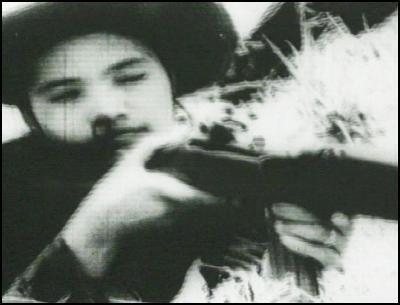
"A little girl whose father died in an American attack," becomes a smiling hero when her squad "killed 118 American soldiers" according to a jerky 1967 black-and-white video at the guerrilla-built tunnels of Cu Chi. Photo Credit: Photo © by Richard S. Ehrlich
The industrious galleries also reveal a surprising, tourist- driven demand for Ralph Steadman's warped illustration on the cover of Hunter Thompson's book, "Fear and Loathing in Las Vegas."
Prices for copied paintings start at 25 U.S. dollars.
Cash-hungry Vietnamese exploit such capitalist-style opportunities throughout this coastal Southeast Asian nation, despite the northern communists' late 20th century war against free markets.
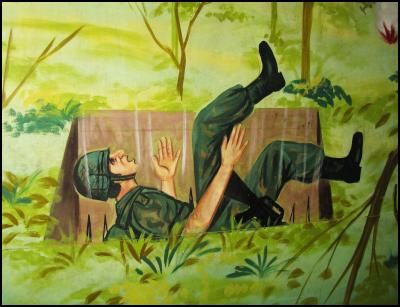
A painting, displayed at the Cu Chi tunnels, shows an American soldier falling into a jungle pit where he is stabbed by hidden bamboo spikes. Photo Credit: Photo © by Richard S. Ehrlich
"The communists still control the government, but now they allow capitalism, because they know they were wrong," said a Vietnamese man who suffered several months in a communist "re-education" camp in 1975 because he collaborated with Americans on the battlefield.
"Ten years ago, things were not so good. But life is almost normal now," he said, sipping coffee sweetened with condensed milk, a favorite brew in this overcrowded, impoverished nation.
"But people don't care so much about democracy or politics now, they just want to make money," he said chuckling ruefully.
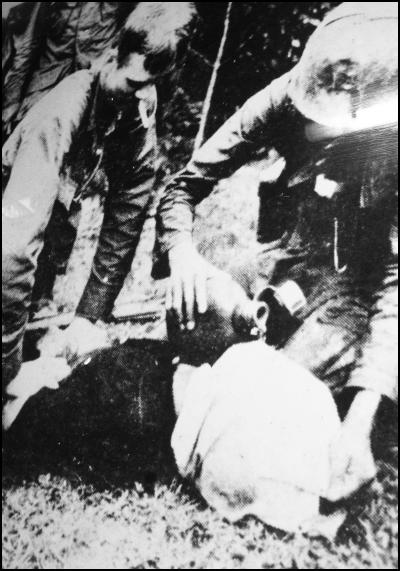
In a photograph displayed in the War Remnants Museum, U.S. troops appear to drown a Vietnamese man by pouring water from a canteen over a cloth hood covering his head -- proof of Americans waterboarding in Vietnam. Photo Credit: Photo © by Richard S. Ehrlich
Vietnam's harsh censorship can be circumvented thanks to free Wi- Fi in many cafes where diners, slurping hot bowls of "pho" noodle soup, can read foreign news reports about Hanoi's human rights abuses.
Today, nearly 35 years after the U.S. lost its war in Vietnam, survivors still mourn the death of more than two million Vietnamese on both sides, and more than 58,000 American invaders.
Much of the fearsome flotsam of Vietnam's "American War," however, is up for sale at second-hand markets, ticketed tourist sites, and souvenir kiosks.
Visitors are charged to enter historic sites which are narrated by communist newsreels describing atrocities committed by U.S. troops against valiant Vietnamese.
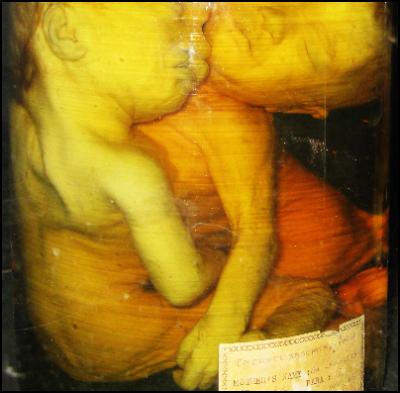
Human birth defects, preserved in a big jar, are displayed as the consequence of U.S. Agent Orange defoliant at the War Remnants Museum in Ho Chi Minh City. Photo Credit: Photo © by Richard S. Ehrlich
"A little girl whose father died in an American attack," becomes a smiling hero when her squad "killed 118 American soldiers" according to a jerky 1967 black-and-white video at the guerrilla- built tunnels of Cu Chi, 60 kms (37 miles) northwest of Ho Chi Minh City, a polluted river port also known as Saigon.
The Cu Chi video portrays Vietnamese men and women burying land mines next to trees, salvaging unexploded U.S. bombs to cannibalize for gun powder and scrap metal, and hiding bamboo spikes in jungle pits so American soldiers can be stabbed.
The 35-minute English-language DVD sells for 3.50 U.S. dollars, labeled with a photo of a Vietnamese soldier descending into a hidden tunnel leading to an underground, 200-km (125-mile) labyrinth.
But communism isn't the only ideology up for sale.
In Ho Chi Minh City, a trendy shop named Propaganda sells new, pricey reprints of Vietnam's vintage anti-American posters, alongside coffee table books showing international anti-war art blasting Washington's current war in Iraq.
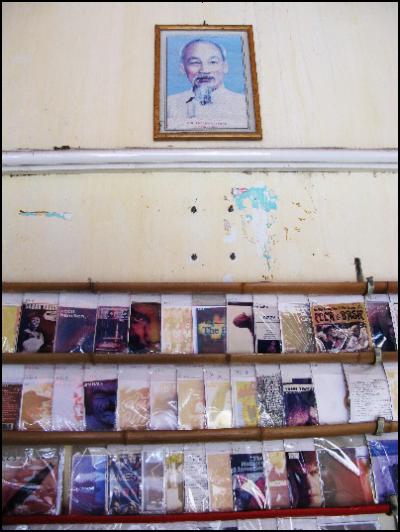
In the central city of Hoi An, the late communist leader Ho Chi Minh's official portrait wistfully smiles in a shop selling insidious counterfeit CDs, including the Mothers of Invention's "Freak Out". Photo Credit: Photo © by Richard S. Ehrlich
One book for sale shows a poster by a foreign artist depicting the late Iraqi leader Saddam Hussein and U.S. President George W. Bush, both naked, smiling, and fondling each other's genitals, above the word "Peace".
Inside the former U.S.-backed South Vietnamese Presidential Palace, paying visitors can gawk at the depressingly tacky office, casino, discotheque, and basement-level telecommunications equipment used during the war.
The palace also shows a propaganda video of Americans killing Vietnamese while manipulating South Vietnam's corrupt regime, before North Vietnam's communists won the war in 1975.
"Some of the rooms in the palace are available for hire, for meetings and banquets," the entry ticket advertises at the renamed Independence Palace.
"The palace also has facilities for celebrations, such as weddings and birthday parties."
A nearby War Remnants Museum -- its name sanitized from its previous name as the War Crimes Museum -- displays an F-5A jet fighter, a Huey helicopter gunship, and other U.S. weapons.
In an exhibited photograph, U.S. troops appear to drown a Vietnamese man by pouring water from a canteen over a cloth hood covering his head -- proof of Americans waterboarding in Vietnam.
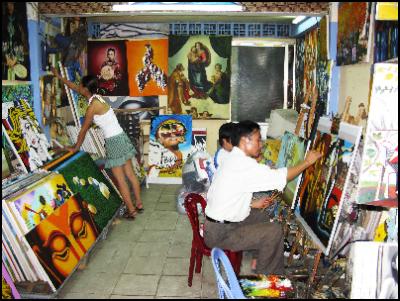
Art galleries sell reproductions of paintings including Ralph Steadman's warped illustration of Hunter Thompson's book, "Fear and Loathing in Las Vegas." Photo Credit: Photo © by Richard S. Ehrlich
Another photo depicts Caucasians in uniform holding assault rifles, while the men show off two decapitated human heads.
"The above picture shows exactly what the brass want you to do in the Nam," the caption says, apparently quoting a U.S. publication from the late 1960s or early 1970s.
"The reason for printing this picture is not to put down G.I.'s, but rather to illustrate the fact that the Army can really fuck over your mind if you let it.
"It's up to you, you can put in your time just trying to make it back in one piece, or you can become a psycho like the Lifer (E-6) in the picture who really digs this kind of shit. It's your choice."
Human birth defects, preserved in a big jar, are displayed as the consequence of U.S. Agent Orange defoliant.
Much of Vietnam's commercially available communism has been spruced up for international audiences, and is ironically underpinned by American technology, complete with Websites and Google gmail addresses.
Richard S Ehrlich is a Bangkok-based journalist who has reported news from Asia since 1978. He is co-author of "Hello My Big Big Honey!", a non-fiction book of investigative journalism, and his web page is http://www.geocities.com/asia_correspondent
ENDS


 Ramzy Baroud: No More 'Deals’ - What Palestinians Want And Will Fight To Achieve
Ramzy Baroud: No More 'Deals’ - What Palestinians Want And Will Fight To Achieve  Peter Dunne: Dunne's Weekly - Mayor Whanau's Rare Win - To Her City's Detriment
Peter Dunne: Dunne's Weekly - Mayor Whanau's Rare Win - To Her City's Detriment Binoy Kampmark: Ironic Dependency - Russian Uranium And The US Energy Market
Binoy Kampmark: Ironic Dependency - Russian Uranium And The US Energy Market Binoy Kampmark: Arrest Warrants From The Hague - The ICC, Netanyahu And Gallant
Binoy Kampmark: Arrest Warrants From The Hague - The ICC, Netanyahu And Gallant Ian Powell: General Practice Visits, Emergency Department Presentations, And Social Determinants Of Health
Ian Powell: General Practice Visits, Emergency Department Presentations, And Social Determinants Of Health Gordon Campbell: On The Hikoi Aftermath
Gordon Campbell: On The Hikoi Aftermath